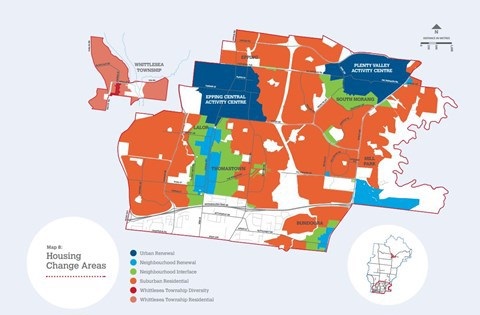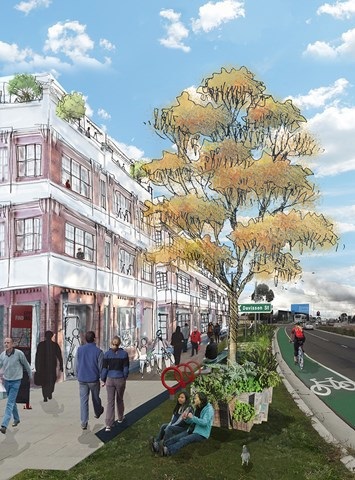Our Housing Diversity Strategy sets out the strategic direction for future housing growth and change in the City of Whittlesea.
Over the next 20 years the established suburbs of Lalor, Thomastown, Mill Park, Epping, Bundoora, parts of South Morang and Whittlesea township are forecast to change. This will require a greater range of housing types.
The Housing Diversity Strategy will ensure more choice of housing is available to residents in these suburbs. It will direct housing growth that takes place in the right way and in appropriate locations.
Adopted in December 2013, this strategy:
- identifies the mix of housing types needed to cater for changing household types
- establishes preferred locations for housing growth close to public transport and services
- identifies Housing Change Areas to provide the community with greater certainty regarding the extent of change that can be expected in different parts of the municipality.
Download our Housing Diversity Strategy
In Word format(DOCX, 9MB)
In PDF format(PDF, 16MB)
As an accessible PDF(PDF, 3MB)
The Housing Change Areas describe the level and type of housing growth and change for each area and are based on a capacity assessment of accessibility to services and facilities, as well as physical and site attributes.
The Housing Diversity Strategy identifies the following Housing Change Areas:
- Urban Renewal
- Neighbourhood Renewal
- Neighbourhood Interface
- Suburban Residential
- Whittlesea Township.

Download descriptions of the housing change areas
In Word format(DOCX, 24KB)
As an accessible PDF(PDF, 194KB)
In July 2013, the State Government introduced Reformed Residential Zones (RRZ). These include:
- Residential Growth Zone
- General Residential Zone
- Neighbourhood Residential Zone.
Councils had until July 2014 to transition the existing residential zones to the new Reformed Residential Zones.
The new zones provide councils with the ability to identify preferred locations for housing growth, as well as areas where intensive growth should not occur. Council can then apply local variations to the zone schedules to show preferred housing types and design.
The Housing Change Areas identified in the strategy will inform Council's transition to the RRZ in the established residential areas of the municipality.

Implementation of the Housing Diversity Strategy will include two planning scheme amendments.
Stage 1 - Planning Scheme Amendment (Amendment C181)
This first amendment implements the Housing Change Areas into the Whittlesea Planning Scheme in the form of the Reformed Residential Zones (RRZ).
From 13 March to 14 April 2014, the community was invited to submit feedback on the proposed amendment.
Amendment C181 then underwent a public hearing process conducted by the Residential Zones Standing Advisory Committee. This resulted in their recommendations to the Minister for Planning and the subsequent approval by the Minister with variations on 22 October 2015.
Stage 2 - Planning Scheme Amendment C200
Following the outcome of Amendment C181, a review was undertaken to identify suitable statutory tools to further support roll-out of the Housing Diversity Strategy. On 3 April 2018, Council resolved to seek authorisation to prepare and exhibit Amendment C200.
Amendment C200 sought to change the way residential development is assessed in the established suburbs including:
- Bundoora
- Thomastown
- Lalor
- Mill Park
- parts of Epping
- parts of South Morang.
The amendment introduced a new local planning policy, sought additional canopy trees in new medium density developments and made design changes to improve housing quality and backyard spaces.
From 4 June to 2 July 2018, the community was invited to give feedback on the proposed amendment. The amendment was subsequently approved by the Minister for Planning on 9 May 2019.
Amendment C200 was implemented into the planning scheme via a local planning policy at Clause 22.16, Schedules 4 and 5 to the General Residential Zone (Clause 32.08) and Schedule 1 to the Residential Growth Zone (Clause 32.07).
Planning Scheme Amendment C200 is expected to enhance the liveability of neighbourhoods by:
- increasing urban tree canopy coverage to enhance the amenity of residential neighbourhoods, increase community resilience to urban heat island effect and decrease the cost of living for residents due to the localised cooling effect of trees
- locating the highest level of housing change close to public transport, services and employment with the flow-on effect of reducing carbon emissions, increasing the sustainability of development, reducing transport costs for residents and increasing labour supply for local employers
- encouraging the development of more accessible dwellings close to transport, services and employment, which supports existing residents to age in place.